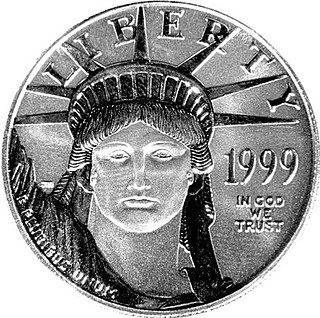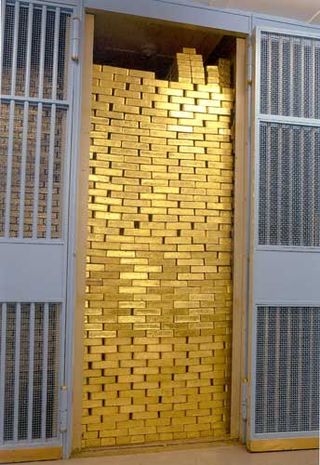Related Research Articles

Palladium is a chemical element with the symbol Pd and atomic number 46. It is a rare and lustrous silvery-white metal discovered in 1803 by the English chemist William Hyde Wollaston. He named it after the asteroid Pallas, which was itself named after the epithet of the Greek goddess Athena, acquired by her when she slew Pallas. Palladium, platinum, rhodium, ruthenium, iridium and osmium form a group of elements referred to as the platinum group metals (PGMs). They have similar chemical properties, but palladium has the lowest melting point and is the least dense of them.

A commodity market is a market that trades in the primary economic sector rather than manufactured products, such as cocoa, fruit and sugar. Hard commodities are mined, such as gold and oil. Futures contracts are the oldest way of investing in commodities. Commodity markets can include physical trading and derivatives trading using spot prices, forwards, futures, and options on futures. Farmers have used a simple form of derivative trading in the commodity market for centuries for price risk management.

Precious metals are rare, naturally occurring metallic chemical elements of high economic value. Chemically, the precious metals tend to be less reactive than most elements. They are usually ductile and have a high lustre. Historically, precious metals were important as currency but are now regarded mainly as investment and industrial raw materials. Gold, silver, platinum, and palladium each have an ISO 4217 currency code.

Bullion is non-ferrous metal that has been refined to a high standard of elemental purity. The term is ordinarily applied to bulk metal used in the production of coins and especially to precious metals such as gold and silver. It comes from the Anglo-Norman term for a melting-house where metal was refined, and earlier from French bouillon, "boiling". Although precious metal bullion is no longer used to make coins for general circulation, it continues to be held as an investment with a reputation for stability in periods of economic uncertainty. To assess the purity of gold bullion, the centuries-old technique of fire assay is still employed, together with modern spectroscopic instrumentation, to accurately determine its quality.
The London Gold Fixing is the setting of the price of gold that takes place via a dedicated conference line. It was formerly held on the London premises of Nathan Mayer Rothschild & Sons by the members of The London Gold Market Fixing Ltd.
A bullion coin is a coin struck from highly refined precious metal (bullion) and kept as a store of value or an investment rather than used in day-to-day commerce. A bullion coin is distinguished by its weight and fineness on the coin. Unlike rounds, bullion coins are minted by government mints and have a legal tender face value. Bullion coins can have fineness ranging from 91.9% to 99.99% purity.

Of all the precious metals, gold is the most popular as an investment. Investors generally buy gold as a way of diversifying risk, especially through the use of futures contracts and derivatives. The gold market is subject to speculation and volatility as are other markets. Compared to other precious metals used for investment, gold has been the most effective safe haven across a number of countries.

A gold bar, also called gold bullion or gold ingot, is a quantity of refined metallic gold of any shape that is made by a bar producer meeting standard conditions of manufacture, labeling, and record keeping. Larger gold bars that are produced by pouring the molten metal into molds are called ingots. Smaller bars may be manufactured by minting or stamping from appropriately rolled gold sheets. The standard gold bar held as gold reserves by central banks and traded among bullion dealers is the 400-troy-ounce Good Delivery gold bar. The kilobar, which is 1,000 grams in mass, and a 100 troy ounce gold bar are the bars that are more manageable and are used extensively for trading and investment. The premium on these bars when traded is very low over the spot value of the gold, making it ideal for small transfers between banks and traders. Most kilobars are flat, although some investors, particularly in Europe, prefer the brick shape.

Silver may be used as an investment like other precious metals. It has been regarded as a form of money and store of value for more than 4,000 years, although it lost its role as legal tender in developed countries when the use of the silver standard came to an end in 1935. Some countries mint bullion and collector coins, however, such as the American Silver Eagle with nominal face values. In 2009, the main demand for silver was for industrial applications (40%), jewellery, bullion coins, and exchange-traded products. In 2011, the global silver reserves amounted to 530,000 tonnes.
GFMS are research and consultancy company for the precious metal markets. Since 2011 they have been part of Thomson Reuters. As well as other commodities, they research gold, silver, platinum, palladium, and copper trading.

The London Bullion Market Association, established in 1987, is the international trade association representing the global Over The Counter (OTC) bullion market, and defines itself as "the global authority on precious metals". It has a membership of approximately 150 firms globally, including traders, refiners, producers, miners, fabricators, as well as those providing storage and secure carrier services.

Platinum as an investment is often compared in financial history to gold and silver, which were both known to be used as money in ancient civilizations. Experts posit that platinum is about 15–20 times scarcer than gold and approximately 60–100 times scarcer than silver, on the basis of annual mine production. Since 2014, platinum prices have fallen lower than gold. Approximately 75% of global platinum is mined in South Africa.

Philip Klapwijk is an economist in precious metals commodities markets.

The Good Delivery specification is a set of rules issued by the London Bullion Market Association (LBMA) describing the physical characteristics of gold and silver bars used in settlement in the wholesale London bullion market. It also puts forth requirements for listing on the LBMA Good Delivery List of approved refineries.
Silver exchange-traded products are exchange-traded funds (ETFs), exchange-traded notes (ETNs) and closed-end funds (CEFs) that aim to track the price of silver. Silver exchange-traded products are traded on the major stock exchanges including the London and New York Stock Exchanges. The U.S Geological Survey cites the emergence of silver ETFs as a significant factor in the 2007-2011 price rise of silver. As of September 2011, the largest of these funds holds the equivalent of over one third of the world's total annual silver production.
MKS (Switzerland) SA is a trader of precious metals. Based in Geneva, the group employs approximately 1,000 workers. MKS is an associate of the London Bullion Market Association (LBMA), and its subsidiary PAMP has been on the LBMA’s Gold List, widely recognised in the financial services industry as the indicator of quality, since 1987.

Vaulted gold denotes gold bullion stored in bank vaults. Buyers of vaulted gold obtain outright ownership of the physical gold which is held for them in a vault. This is unlike structured gold products such as Gold based exchange traded funds (ETFs) which only reflect the price of gold while the investor has no ownership of the gold.
A gold IRA or precious metals IRA is an Individual Retirement Account in which physical gold or other approved precious metals are held in custody for the benefit of the IRA account owner. It functions the same as a regular IRA, only instead of holding paper assets, it holds physical bullion coins or bars. Precious metals IRAs are usually self-directed IRAs, a type of IRA where the custodian allows more diverse investments to be held in the account.
PAMP SA is an independently operated precious metals refining and fabricating company and member of the MKS Group. It was established in 1977 in Ticino, Switzerland.
The London Platinum and Palladium Market (LPPM) is an over-the-counter trading centre for platinum and palladium and a commodity trading association. London has always been a centre for the research in and development of most of the platinum group metals. Trade was established in the early 20th century, typically by existing dealers of gold and silver. The LPPM has been involved in fixing the world market prices of platinum and palladium since 1989.
References
- ↑ "Science Engineering & Sustainability: Gold price historical chart: Peak gold price". Science Engineering & Sustainability. Retrieved 4 May 2019.
- ↑ "LBMA - Clearing Statistics". www.lbma.org.uk. Retrieved 2 July 2019.
- ↑ Paul Mylchreest, Thunder Road Report (PDF) GATA, p. 10; (15 October 2009). Retrieved 21 March 2010
- ↑ Eric King, Interview with Andrew Maguire and GATA board member Adrian Douglas Archived 15 June 2011 at the Wayback Machine King World News (30 March 2010). Retrieved 6 May 2011
- 1 2 Susanne Capano, A Guide to the London Precious Metals Markets Archived 16 July 2011 at the Wayback Machine Published jointly by the LBMA and the London Platinum and Palladium Market (LPPM), p. 6 (August 2008). Retrieved 21 March 2010
- 1 2 Paul Mylchreest, Thunder Road Report (PDF) GATA, p. 11 (15 October 2009). Retrieved 21 March 2010
- ↑ "LBMA – FAQs". The London Bullion Market Association. Retrieved 2 April 2015.
- ↑ "LBMA – Membership". The London Bullion Market Association. Retrieved 2 April 2015.
- ↑ Cedricks, Rob, ed. (1 April 2015). "VTB is first Russian bank to enter LBMA". CISTran Finance. Chicago, Illinois. Retrieved 2 April 2015.
- ↑ 2009 LBMA Forecast winners http://www.gfms.co.uk/Press%20Releases/2009%20Price%20Forecast%20Winners.pdf (PDF) (15 January 2010). Retrieved 29 August 2013